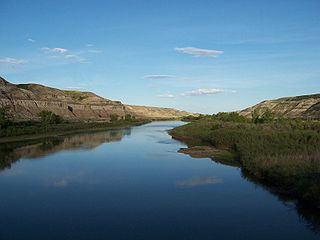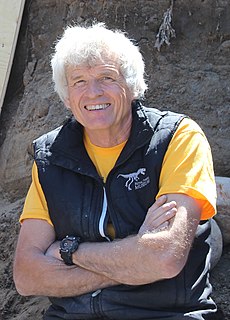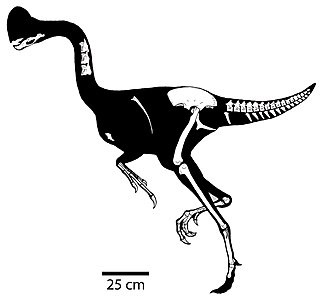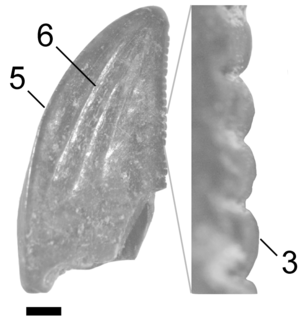
John Ware was a Canadian cowboy who was influential in the early years of the burgeoning ranching industry in Southern Alberta. Remembered for his excellent horsemanship, he was among the first ranchers in Alberta, arriving in 1882 on a cattle drive from the United States and settling to ranch until his death in 1905.

Centrosaurus is a genus of herbivorous ceratopsian dinosaur from the Late Cretaceous of Canada. Their remains have been found in the Dinosaur Park Formation, dating from 76.5 to 75.5 million years ago.

The Red Deer River is a river in Alberta and a small portion of Saskatchewan, Canada. It is a major tributary of the South Saskatchewan River and is part of the larger Saskatchewan-Nelson system that empties into Hudson Bay.

Philip John Currie is a Canadian palaeontologist and museum curator who helped found the Royal Tyrrell Museum of Palaeontology in Drumheller, Alberta and is now a professor at the University of Alberta in Edmonton. In the 1980s, he became the director of the Canada-China Dinosaur Project, the first cooperative palaeontological partnering between China and the West since the Central Asiatic Expeditions in the 1920s, and helped describe some of the first feathered dinosaurs. He is one of the primary editors of the influential Encyclopedia of Dinosaurs, and his areas of expertise include theropods, the origin of birds, and dinosaurian migration patterns and herding behavior. He was one of the models for palaeontologist Alan Grant in the film Jurassic Park.

Chirostenotes is a genus of oviraptorosaurian dinosaur from the late Cretaceous of Alberta, Canada. The type species is Chirostenotes pergracilis.

Zapsalis is a genus of dromaeosaurine theropod dinosaurs. It is a tooth taxon, often considered dubious because of the fragmentary nature of the fossils, which include teeth but no other remains.

Sphaerotholus is a genus of pachycephalosaurid dinosaur from the Upper Cretaceous of the western United States and Canada. To date, three species have been described: the type species, S. goodwini, from the Den-na-zin Member of the Kirtland Formation of San Juan County, New Mexico, USA; S. buchholtzae, from the Hell Creek Formation of western Carter County, Montana, USA and the Frenchman Formation of Saskatchewan, Canada; and S. edmontonensis, from the Horseshoe Canyon Formation of Alberta, Canada.

Prenoceratops, is a genus of ceratopsian dinosaur from the Late Cretaceous Period. Its fossils have been found in the upper Two Medicine Formation in the present-day U.S. state of Montana, in Campanian age rock layers that have been dated to 74.3 million years ago. Fossils were also found in the Oldman Formation in the modern day Canadian province of Alberta, dating to around 77 million years ago.

The Judith River Formation is a fossil-bearing geologic formation in Montana, and is part of the Judith River Group. It dates to the Late Cretaceous, between 80 and 75 million years ago, corresponding to the "Judithian" land vertebrate age. It was laid down during the same time period as portions of the Two Medicine Formation of Montana and the Oldman Formation of Alberta. It is an historically important formation, explored by early American paleontologists such as Edward Drinker Cope, who named several dinosaurs from scrappy remains found here on his 1876 expedition. Modern work has found nearly complete skeletons of the hadrosaurid Brachylophosaurus.

Caenagnathidae is a family of bird-like maniraptoran theropod dinosaurs from the Cretaceous of North America and Asia. They are a member of the Oviraptorosauria, and close relatives of the Oviraptoridae. Like other oviraptorosaurs, caenagnathids had specialized beaks, long necks, and short tails, and would have been covered in feathers. The relationships of caenagnathids were long a puzzle. The family was originally named by Raymond Martin Sternberg in 1940 as a family of flightless birds. The discovery of skeletons of the related oviraptorids revealed that they were in fact non-avian theropods, and the discovery of more complete caenagnathid remains revealed that Chirostenotes pergracilis, originally named on the basis of a pair of hands, and Citipes elegans, originally thought to be an ornithomimid, named from a foot, were caenagnathids as well.

Albertaceratops was a genus of centrosaurine horned dinosaur from the middle Campanian-age Upper Cretaceous Oldman Formation of Alberta, Canada.

Horseshoe Canyon is a region of badlands surrounded by prairie in the province of Alberta, Canada. It is located about 17 km (11 mi) west of the town of Drumheller, Alberta, along Highway 9.

The Cadomin Formation is a stratigraphic unit of Early Cretaceous age in the western part of the Western Canada Sedimentary Basin. It is extends from southeastern British Columbia through western Alberta to northeastern British Columbia, and it contains significant reservoirs of natural gas in some areas. It was named after the mining town of Cadomin, which is an acronym of "Canadian Dominion Mining".

Boreonykus is an extinct genus of dromaeosaurid dinosaur, that lived during the Late Cretaceous in the area of present Canada.

Albertavenator is a genus of small troodontid theropod dinosaur, known from the early Maastrichtian in the Cretaceous period. It contains a single species, A. curriei, named after paleontologist Phil Currie, based on a partial left frontal found in the Horseshoe Canyon Formation of Alberta during the 1990s. Albertavenator's discovery indicates that small dinosaur diversity may be underestimated at present due to the difficulty in identifying species from fragmentary remains.

The Philip J. Currie Dinosaur Museum is a paleontology museum located in Wembley, Alberta, Canada. The museum is situated within a 3,800-square-metre-building (41,000 sq ft) constructed in 2015, and is named for renowned Canadian paleontologist Philip J. Currie.
Victoria Megan Arbour is a Canadian evolutionary biologist and vertebrate palaeontologist at Royal BC Museum, where she is Curator of Palaeontology. An "expert on the armoured dinosaurs known as ankylosaurs", Arbour analyzes fossils and creates 3-D computer models. She named the possible pterosaur Gwawinapterus from Hornby Island, and a partial ornithischian dinosaur from Sustut Basin, British Columbia, and has participated in the naming of the ankylosaurs Zuul, Zaraapelta, Crichtonpelta, and Ziapelta.
Dinosaur Ridge is a ridge in Colorado, United States.
Thanatotheristes is a genus of tyrannosaurid dinosaur from the Late Cretaceous of Laramidia, approximately 80.1-79.5 Ma. Thanatotheristes contains only one species, T. degrootorum. Fossils of this taxon are found in the Foremost Formation of Alberta, Canada, coexisting with medium-sized ceratopsids like Xenoceratops foremostensis and small pachycephalosaurids like Colepiocephale lambei.
















